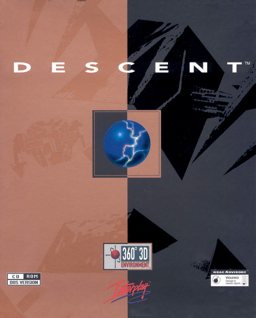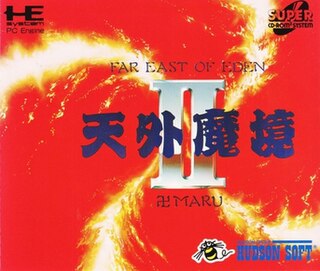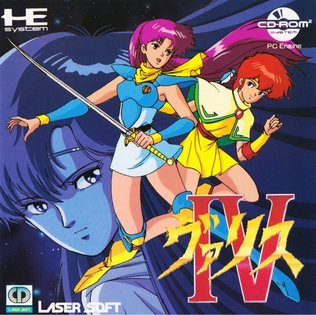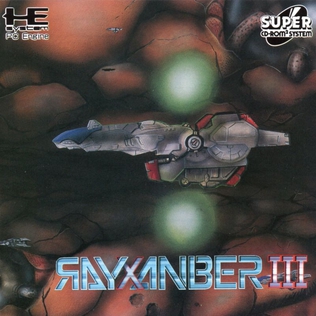Related Research Articles

Rise of the Triad: Dark War is a first-person shooter video game, developed and published by Apogee Software in 1995. The player can choose one of five different characters to play as, each bearing unique attributes such as height, speed, and endurance. The game's story follows these five characters who have been sent to investigate a deadly cult, and soon become aware of a deadly plot to destroy a nearby city. Its remake was designed by Interceptor Entertainment and released by Apogee Games in 2013. The shareware version of the game is titled Rise of the Triad: The HUNT Begins.

The TurboGrafx-16, known as the PC Engine outside North America, is a home video game console designed by Hudson Soft and sold by NEC Home Electronics. It was the first console marketed in the fourth generation, commonly known as the 16-bit era, though the console has an 8-bit central processing unit (CPU) coupled with a 16-bit graphics processor. It was released in Japan in 1987 and in North America in 1989. In Europe the Japanese model was unofficially imported and distributed in the United Kingdom and France from 1988. In Japan, the system was launched as a competitor to the Famicom, but the delayed United States release meant that it ended up competing with the Sega Genesis and later the Super NES.
Shovelware is a term for individual video games or software bundles known more for the quantity of what is included than for the quality or usefulness.

Descent is a first-person shooter (FPS) game developed by Parallax Software and released by Interplay Productions in 1995 for MS-DOS, and later for Macintosh, PlayStation, and RISC OS. It popularized a subgenre of FPS games employing six degrees of freedom and was the first FPS to feature entirely true-3D graphics. The player is cast as a mercenary hired to eliminate the threat of a mysterious extraterrestrial computer virus infecting off-world mining robots. In a series of mines throughout the Solar System, the protagonist pilots a spaceship and must locate and destroy the mine's power reactor and escape before being caught in the mine's self-destruction, defeating opposing robots along the way. Players can play online and compete in either deathmatches or cooperate to take on the robots.

MacLife is an American monthly magazine published by Future US. It focuses on the Macintosh personal computer and related products, including the iPad and iPhone. It was sold as a print product on newsstands, but is now exclusively a digital–only product distributed through Magazines Direct, or through the Mac|Life app which can be obtained via the App Store. Between September 1996 and February 2007, the magazine was known as MacAddict.

The PC Engine SuperGrafx, also known as simply the SuperGrafx, is a fourth-generation home video game console manufactured by NEC Home Electronics and released in Japan in 1989. It is the successor system to the PC Engine, released two years prior. Originally known as the PC Engine 2 during production stages, it was purported as a true 16-bit home console, featuring improved graphics and audio capabilities over its predecessor.
Homebrew, when applied to video games, refers to software produced by hobbyists for proprietary video game consoles which are not intended to be user-programmable. The official documentation is often only available to licensed developers, and these systems may use storage formats that make distribution difficult, such as ROM cartridges or encrypted CD-ROMs. Many consoles have hardware restrictions to prevent unauthorized development.

Akemi Takada is a Japanese manga artist and anime character designer born in Tokyo, Japan. Her character-design work is one of the more recognizable styles of the 1980s, when she worked on series like Creamy Mami and Kimagure Orange Road. She is also noted for her long collaboration with director Mamoru Oshii. She graduated from Tama Art University, after which she worked for Tatsunoko Pro. She is currently a freelance manga artist with her own studio, though she is also a member of the creative group Headgear. She also has her own designer jewelry store called Diakosmos.
A game demo is a trial version of a video game that is limited to a certain time period or a point in progress. A game demo comes in forms such as shareware, demo disc, downloadable software, and tech demos.
Nectaris, occasionally released as Military Madness, is a series of sci-fi-themed, hex map turn-based strategy games for a variety of systems. The games were developed by Hudson Soft. The company was absorbed by Konami in 2012, and as a result Konami owns the rights to the series.

Military Madness is a 1989 turn-based strategy video game originally developed and published by Hudson Soft in Japan and NEC in North America for the TurboGrafx-16. It is the first entry in the Nectaris series. Set in the year 2089, players take command of the Allied-Union forces in a desperate offense against the Axis-Xenon Empire army on the Moon before they launch the S.A.M. weapon to obliterate Earth. Its gameplay consists of moving units into positions to confront enemies in turn-based encounters determined by multiple factors, capturing factories to produce resources and repair units in order to occupy the enemy prison camp or destroy all enemy forces.

Tengai Makyō II: Manji Maru, also known as Far East of Eden II: Manji Maru, is a role-playing video game and the second game in the Tengai Makyō series. It was first released in 1992 for the PC Engine Super CD-ROM² by Hudson Soft and developed by Red Company.

Valis II is a 1989 action-platform video game originally developed by Laser Soft, published by Telenet Japan and NEC for the PC Engine CD-ROM²/TurboGrafx-CD. A home computer version was released for PC-8801, MSX2, PC-9801 and X68000. A super deformed-style remake was also released in 1992 for the Sega Mega Drive/Genesis. It is the second entry in the eponymous series. It stars Yuko Asou, a Japanese schoolgirl teenager chosen to become the Valis warrior by wielding the titular mystical sword, after defeating the demon lord Rogles. The dream world Vecanti fell under the rule of emperor Megas, whose hatred towards his brother Rogles and bloodthirsty tendencies seeks to wipe out traces of the former tyrant, including his supporters. Gameplay varies between each version but all share similar elements, as the player explores and search for items and power-ups, while fighting enemies and defeat bosses.

Valis IV is a 1991 action-platform video game originally developed by Laser Soft and published by Telenet Japan for the PC Engine CD-ROM². A vastly different version titled Super Valis IV was published in Japan by Telenet in 1992 and in North America by Atlus Software in 1993 for the Super Nintendo Entertainment System. It is the fourth and final main entry in the eponymous series. Following on the events of Valis III, Yuko became a goddess and has watched over Vecanti since Glames' defeat. The dark world prince Galgear, who lost self-control after acquiring a magical ring, broke from his fifteen-year imprisonment by the gods of Vecanti, kidnapping Valna and being pursued by troops led by Cham. Lena, a member of Cham's band, is joined by her sister Amu and the prince's father Asfal on a journey to retrieve the titular sword and defeat Galgear.

Dragon Slayer: The Legend of Heroes is a 1989 role-playing game developed by Nihon Falcom. It is the sixth game in the Dragon Slayer series and the first in The Legend of Heroes franchise.

Gate of Thunder is a 1992 scrolling shooter video game developed by Red Company and published by Hudson Soft for the TurboGrafx-CD. It was the first game released in North America to support the Super CD-ROM² format and served as one of the pack-in games for the TurboDuo, a two-in-one system which runs both TurboGrafx-CD and TurboGrafx-16 titles, where it was bundled with Bonk's Adventure, Bonk's Revenge and Bomberman on the same disc. In the game, the player controls the Hunting Dog space fighter craft, piloted by space cop Hawk. Alongside his ally Esty, piloting the Wild Cat support ship, Hawk must stop General Don Jingi and his Obellon armada from obtaining the powerful "Starlight" energy source from planet Aries.
A fan game is a video game that is created by fans of a certain topic or IP. They are usually based on one, or in some cases several, video game entries or franchises. Many fan games attempt to clone or remake the original game's design, gameplay, and characters, but it is equally common for fans to develop a unique game using another as a template. Though the quality of fan games has always varied, recent advances in computer technology and in available tools, e.g. through open source software, have made creating high-quality games easier. Fan games can be seen as user-generated content, as part of the retrogaming phenomena, and as expression of the remix culture.

Rayxanber II is a 1991 horizontally scrolling shooter video game developed and published by Data West for the PC Engine CD-ROM². It is the sequel to Rayxanber, which was released earlier in 1990 for the FM Towns. In the game, the player assumes the role of a fighter pilot controlling the Eliminate Scanner AD space craft to protect Earth against an alien invasion led by the returning Zoul Empire. The title was created by Team 50, a group within Data West that previously worked on the first entry for FM Towns. The music was scored by Yasuhito Saito, who composed for the original entry and also worked on titles such as Layla and The 4th Unit series.

Rayxanber III is a 1992 scrolling shooter video game developed and published by Data West for the PC Engine Super CD-ROM². It is a follow-up to Rayxanber II, which was released earlier in 1991 for the PC Engine CD-ROM², and the last entry in the Rayxanber trilogy. In the game, the player assumes the role of a fighter pilot controlling the ES3 Donner Kyle space craft deployed into the homeworld of the Zoul Empire, in retaliation for the destruction of a mother ship from Earth. It retains the same gameplay as its predecessors, with the players fighting against an assortment of enemy forces while avoiding collision with their projectiles and other obstacles.
References
- 1 2 Gifford, Kevin. "PC Engine FAN". I ♥ The PC Engine. Archived from the original on 2019-11-16. Retrieved 2014-03-04.
- ↑ "Akemi Takada Works - PC Engine FAN". Akemi Takada Homage. Archived from the original on 5 March 2014. Retrieved 4 March 2014.
- ↑ "Demo disc, guide book & magazine coverage for Neo Nectaris". Neo Nectaris FAQ. Esteban.
- 1 2 "Super PC Engine FAN Deluxe Special CD-ROM Vol.1 (January 1, 1997)". The Shareware CD Archive. The Internet Archive. January 1997. Retrieved 4 March 2014.
- 1 2 "Super PC Engine FAN Deluxe Special CD-ROM Vol.2 (March 1, 1997)". The Shareware CD Archive. The Internet Archive. March 1997. Retrieved 4 March 2014.
- 1 2 "PC Engine Fan: Special CD-ROM Vol. 1 (TurboGrafx CD)". MobyGames. Retrieved 4 March 2014.
- ↑ "Akazukin Cha-Cha and PC Engine Fan Special CD-ROM Vol.2 for PC-FX". Retrostuff.org. 6 January 2014. Retrieved 4 March 2014.
- ↑ "PC Engine FAN Special CD-ROM Vol.3 (August 31, 1996)". The Shareware CD Archive. The Internet Archive. 31 August 1996. Retrieved 4 March 2014.